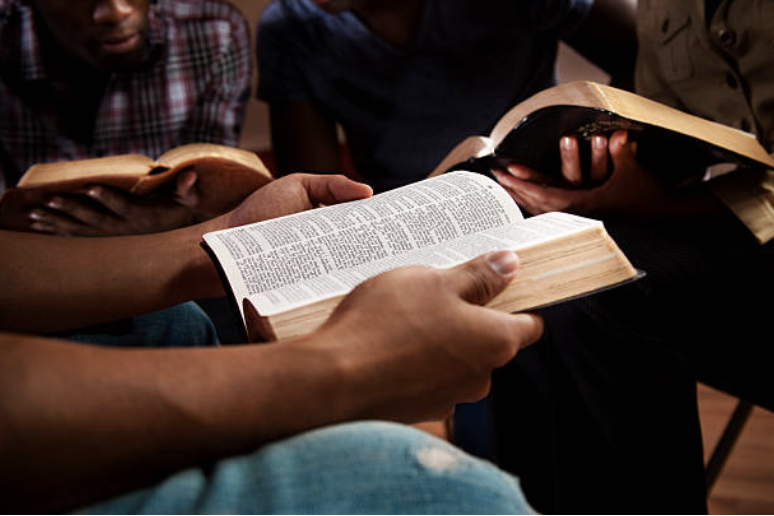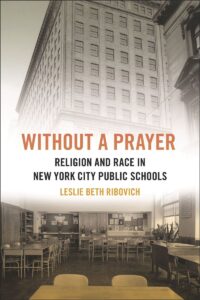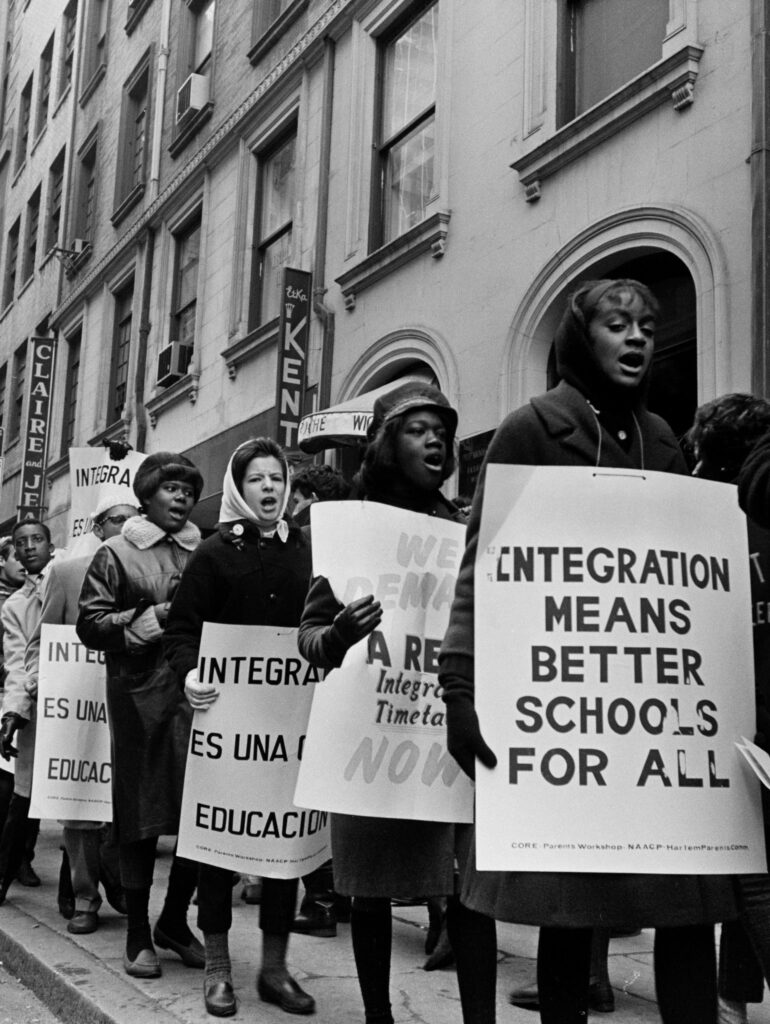Public Schools, Religion, and Race
An excerpt from “Without a Prayer: Religion and Race in New York City Public Schools”

(Image source: iStock)
This summer, Oklahoma announced that it will require public school educators to teach the Bible in their classrooms. Louisiana declared that the Ten Commandments will be posted in public schools. These pronouncements come in response to social and racial justice movements and demographic changes. Candidates running for political office have articulated U.S. voters’ hopes and fears—many of them racialized—in terms of children and their futures. This is not the first time the United States has seen such moves. Yet, why and how have so many turned to U.S. public schools and children to articulate their visions for the future, many of them using religious rhetoric? In my recent book, Without a Prayer: Religion and Race in New York City Public Schools, I explore this question in a specific time and place: New York City in the mid-twentieth century.
Below is an excerpt from the introduction and chapter six, where I set out the book’s aims and offer an example of how one educator engaged with religion and race to express her views on the possibilities of public education.
***
Educators reading the Public Schools of New York Staff Bulletin on September 9, 1963 encountered two pieces of seismic news. On the left side of the bulletin’s front page, an article announced that the city would follow the Supreme Court of the United States’ Engel v. Vitale and Abington v. Schempp rulings, which found school prayer and devotional Bible-reading unconstitutional in American public schools. On the right side of the page, a separate article laid out the city’s plan for racial integration. The side-by-side layout framed secularization and desegregation as separate stories, each of which related to public schools, but not to the other. However, it was no coincidence that public school secularization and desegregation were happening, and failing, simultaneously. Many of the programs and priorities of this era, from juvenile delinquency prevention to moral and spiritual values curricula and racial integration advocacy, straddled these supposedly distinct issues, tethered by the invented tradition—Judeo-Christianity—and its whiteness. Whiteness undergirded concepts of a “Judeo-Christian” America in areas relating overtly to religion, such as Bible-reading in schools, even as that religious tradition undergirded schools’ efforts focused on race, such as integration.
 My work offers an as yet untold story about religion’s role in shaping twentieth-century American public education. Rather than existing in a separate sphere, religion structured government policies on race and everyday school practices before and after the 1962 and 1963 US Supreme Court decisions holding school prayer and Bible-reading unconstitutional. Using New York City as a window into a national story, I argue that these Supreme Court decisions failed to remove religion from public schools because religion—from the government-endorsed Judeo-Christianity to Pan-African theology—framed how Americans interacted with public schools far beyond prayer and Bible-reading, and continued to do so, through public education’s process of collective moral formation. Intersections of religion and race informed the major conversations about twentieth-century American public education, from school desegregation, youth crime, and multicultural education to government aid to religious schools, community control of education, and prayer and Bible-reading. Both secularization and desegregation in New York City public schools inculcated students into white Christian norms through a repertoire of ideas and practices, as part of their project of shaping students into citizens, at the same time that parents, teachers, and community members drew on, resisted, and reimagined that repertoire to create citizens of a different sort.
My work offers an as yet untold story about religion’s role in shaping twentieth-century American public education. Rather than existing in a separate sphere, religion structured government policies on race and everyday school practices before and after the 1962 and 1963 US Supreme Court decisions holding school prayer and Bible-reading unconstitutional. Using New York City as a window into a national story, I argue that these Supreme Court decisions failed to remove religion from public schools because religion—from the government-endorsed Judeo-Christianity to Pan-African theology—framed how Americans interacted with public schools far beyond prayer and Bible-reading, and continued to do so, through public education’s process of collective moral formation. Intersections of religion and race informed the major conversations about twentieth-century American public education, from school desegregation, youth crime, and multicultural education to government aid to religious schools, community control of education, and prayer and Bible-reading. Both secularization and desegregation in New York City public schools inculcated students into white Christian norms through a repertoire of ideas and practices, as part of their project of shaping students into citizens, at the same time that parents, teachers, and community members drew on, resisted, and reimagined that repertoire to create citizens of a different sort.
The history of race and religion in the urban North is the history of desegregation and secularization of public schools. Collective memory about desegregation and secularization of public schools often focuses on the southern United States. We hear about the (increasingly less) rogue school in the “Bible Belt” sponsoring prayer, or we read a sanitized history of Martin Luther King Jr.’s triumph over southern racism. The South shaped American racism and religiosity, but the South alone did not purvey white Christian supremacy. The North did, too, in its own way. Focusing only on the South reinforces stereotypes about Northern innocence, Southern religious fervor, and Black, southern, religious resistance.
Shifting attention to the North requires us to abandon stereotypes and to see how, while the contours differed, Americans revered the public school as a sacred site that produced religious and racial beings through educating the public. Recent decades have seen an influx in scholarship on the Northern Civil Rights Movement, centered in New York City. Reflecting national concerns about school inequality, New York City witnessed the largest school boycott of the American Civil Rights Movement, during which nearly half a million students stayed home. Moreover, a key way to understand racism in the North is to look at desegregation alongside efforts at secularization. Secularization efforts abounded outside the South, which showed that religion existed in public schools there, even as more than half the states had outlawed prayer and Bible-reading by the 1960s. The state-sponsored school prayer case, Engel, originated in New York State before landing at the US Supreme Court. The state’s governing educational body, the New York Board of Regents, had written the prayer at issue in Engel. The Bible-reading and prayer case, Schempp, consolidated cases from Pennsylvania and Maryland, the mid-Atlantic; not the Northeast, but not the South, either. Other significant mid-century Supreme Court religion and school cases began in Illinois and New Jersey.
As one of the most racially and religiously diverse, and one of the most segregated, cities in the country, New York City sheds light on a national story. The Great Migration of African Americans from the Jim Crow South, migration from Puerto Rico, and immigration from Caribbean countries earlier in the century had altered the city’s racial demographics. The racial diversity also contributed to the city’s religious diversity, with New Yorkers across racial demographics practicing Catholicism, Judaism, Yoruba traditions, Santería, Protestantism, religio-racial movements, various combinations of these traditions, and much more. Black Liberation Theology and Pan-Africanism also emerged in New York City, and some New Yorkers vibrantly practiced them. Few places had the demographics to test the American ideal of pluralism as New York did. Diversity in and of itself did not solve segregation or religious establishment, but it did shape their terms of engagement.
New York City also had the largest school system in the country, a complex institution where bureaucracy collided with public opinion. The common story of desegregation in New York City typically goes something like this: Following the US Supreme Court’s 1954 Brown v. Board of Education decision, the New York City Board of Education (the Board) sponsored a Commission on Integration. The Commission developed ideas for zoning, curricula, hiring, and more, but the Board largely did not fund or actualize the ideas. Instead, the Board proposed insufficient plans to effect change. Black and Puerto Rican New Yorkers organized the 1964 Freedom Day School Boycott for desegregation and school resources. When the Board still failed to make any changes, three districts experimented with controlling their own schools, having community boards responsible for curricula, hiring, and more. Teachers struck, leading to the longest boycott in the school system’s history. The strike laid bare existing racial tensions, as many teachers were white and Jewish, while many students were Black or Puerto Rican and not Jewish. To avoid further disruption, the Board decentralized the school system but maintained control over crucial decisions, including zoning districts. The Board remained decentralized until the early 2000s, when the Department of Education formed.

(Image source: New York Times)
Community control did not lead to desegregation or more equity across the city, so, until recently, scholars and the public have generally embraced the idea that community control failed. Yet, whether community control succeeded in New York City depends on how we understand its aims. Community control did not end segregation, but that was not the goal of its proponents; self-determination was. From that perspective, Black and Puerto Rican New Yorkers successfully built grassroots alliances that fueled future social justice advocacy, even though the immediate goal of those groups, community control of public schools, ended. Even less frequently discussed than Black and Puerto Rican New Yorkers’ successful coalition-building is that it was their understandings of community and freedom, drawing from Black churches, liberation theology, Pan-Africanism, and more, that helped to fuel the community control movement. While community control may have ended, it showed that another form of public education was possible, one where Black and Puerto Rican religious and racial worldviews were manifest in public education.
Take, for instance, the story of schoolteacher Edwina Chavers Johnson. Narratives of Black Americans as the true inheritors of the US nation were a form of religious and racial world-making that engaged national rituals and stories. Johnson may not have seemed like a candidate for a community control supporter given her widespread efforts to work with the government entities. If community control were only about separatism, she would not be. However, Chavers Johnson tried every strategy she could, and by the late 1960s she had become especially invested in educating Black teachers to teach Black children. She advocated for community control because, as she outlined in her 1968 essay, “An Alternative to Miseducation for the Afro-American People,” history taught her that the American educational system would rarely defend Black people’s place in American history and Black students’ place in public schools. So, she argued, Black people must create their own educational spaces.
Chavers Johnson’s project drew on religious dimensions of Black collective narration without being explicitly religious. Her 1963 “Guide for Teachers on Contributions of Afro-Americans to the American Culture” covered grades K-6. One activity encouraged third- and fourth-grade students at their desks, having read poems by Phyllis Wheatley and Gwendolyn Brooks, to write to the authors (even if Wheatley was no longer alive) or compose their own poems inspired by Wheatley and Brooks. This lesson positioned the authors as the students’ ancestors, elders with whom they could communicate. These American ancestors could give students their own narrative in the United States. As religious studies scholar Laurie Maffly-Kipp has shown, reconstructing history for a people wrongly called “historyless” was sacred work.
For Chavers Johnson, the public school proved a significant space for conveying a sacred race history because of its didactic structure and built-in futurity. Her approach saw time as supple, with the future intimately connected to the past. Her guide included a calendar with birth dates of important figures in Black history, so that children could mark Harriet Tubman’s leadership in March or Countee Cullen’s on his May 30 birthday. Through ritually memorializing ancestors, pupils guided by Chavers Johnson tapped into how sacred race histories were prominently transmitted: through “commemorations, ritualized feasts, fasts, and celebrations that captured stories of the collective past, present, and future.” Chavers Johnson planned lessons with overviews of Black figures’ contributions and activities related to the figures. Honoring Black figures in American history brought the past to the present, making these figures come alive as leaders for public school children. Rituals also brought the figures into the future through educating children who could create a new America.
Rituals associated with the school calendar restructured time so that a Black, rather than a white, collective defined America. In a piece she wrote for the African-American Teachers Association Forum, a pro-community control newspaper, called “Teacher, Put Some Black on That Calendar!,” Chavers Johnson referred to her earlier guide by contrast to the Judeo-Christian patriotic calendar that put aside time to honor former US presidents, the flag, brotherhood, and Christmas. Re-emphasizing the importance of dates, she pointed out how just in September, teachers could use the many “examples of how dates can be commemorated, taking a birth date of an important Afro-American and weaving the lessons and activities around that person’s life.” For instance, “September we can celebrate Owijira, the West African New Year. September we can dramatize Jesse Owens’ Olympic feats. September we can present Hiram Revels, the first Afro-American Senator, and James Forten who was an inventor and an abolitionist. September we can discuss Alain Locke and the Harlem Renaissance.” By punctuating the broad possibilities for just one month, her plan conveyed to students that Black accomplishment permeated an array of fields—sports, government, industry, and arts—across space and time. Instead of relegating Black history to a particular month, she aimed to saturate the curriculum with religious and racial world-making rituals to correct the notion that only white students ought to see people who looked like them in tales of historical figures. The world to be made was a new America, redeemed by Blackness.
Chavers Johnson’s religious and racial world threatened the centralized Board because its contents challenged the status quo. In her article for the Forum, she wrote, “the Board of Education of New York City,” i.e., the centralized generator of curriculum, “called me in for some meetings,—my work had stamina,—could it be an official document?” However, “That was a consideration which was squelched by some very well-executed Uncle Tomming,” i.e., by Black people whom she understood to be playing into white interests. The response further motivated her to work around educational bureaucracy: “I went into business” and “reached 32 of the 50 states in this country—from a small office which is in my home.” Because of her dedication to trying multiple strategies and her frustration with the Board, her support for community control emerged.
Chavers Johnson’s experience with the Board also inspired her focus on educating and activating Black teachers to better teach about Black history and culture. Community control became an opportunity to challenge the white Judeo-Christian norm. Following the confrontation, she shifted from her focus on all teachers to Black teachers because “Waiting for the Boards of Education or for the Bureaus of Curriculum or Title Projects to initiate action is to wait for the line-up to crematorium. Forget it.” Instead, she sought to identify resources within Black communities through working with the “talented, knowledgeable black educators WHO KNOW OUR HISTORY and who are not being recognized by us because they are not recognized by white people due to their unswerving, uncompromising attitudes.” She wanted to complete the work soon: “There is enough material called units or lesson plans written already by black people for us to put into our home libraries this forthcoming summer, pur [sic] over, and get going with a bang in September, 196[9].” Chavers Johnson organized Black communities because white (and some Black) people had rejected her ideas, not because she unilaterally rejected white people. For Chavers Johnson, solidifying Black people’s belonging in America created a world where Black children would facilitate Black history’s reproduction for future generations.
Seeing religion as part of New York City desegregation and community control through stories like Chavers Johnson’s helps us to shift the story from one of failure to one of complex negotiations and possibilities. The Board’s adoption of what it called “Judeo-Christianity” for teaching American history, preventing juvenile delinquency, and promoting integration as a value contributed to religion’s continuing presence in the schools. At the same time, it illuminates that the ongoing struggles around desegregation and community control resisted the schools’ Judeo-Christian white moral framework and produced original religious and racial worldviews that sustained educational justice efforts for decades to come. Black and Puerto Rican religious and racial creativity thus also continued in public schools following the early 1960s Supreme Court cases, and even beyond the late 1960s’ community control movement.
Leslie Ribovich is Director of the Greenberg Center for the Study of Religion in Public Life and Associate Professor of Religious Studies and Public Policy & Law at Trinity College.